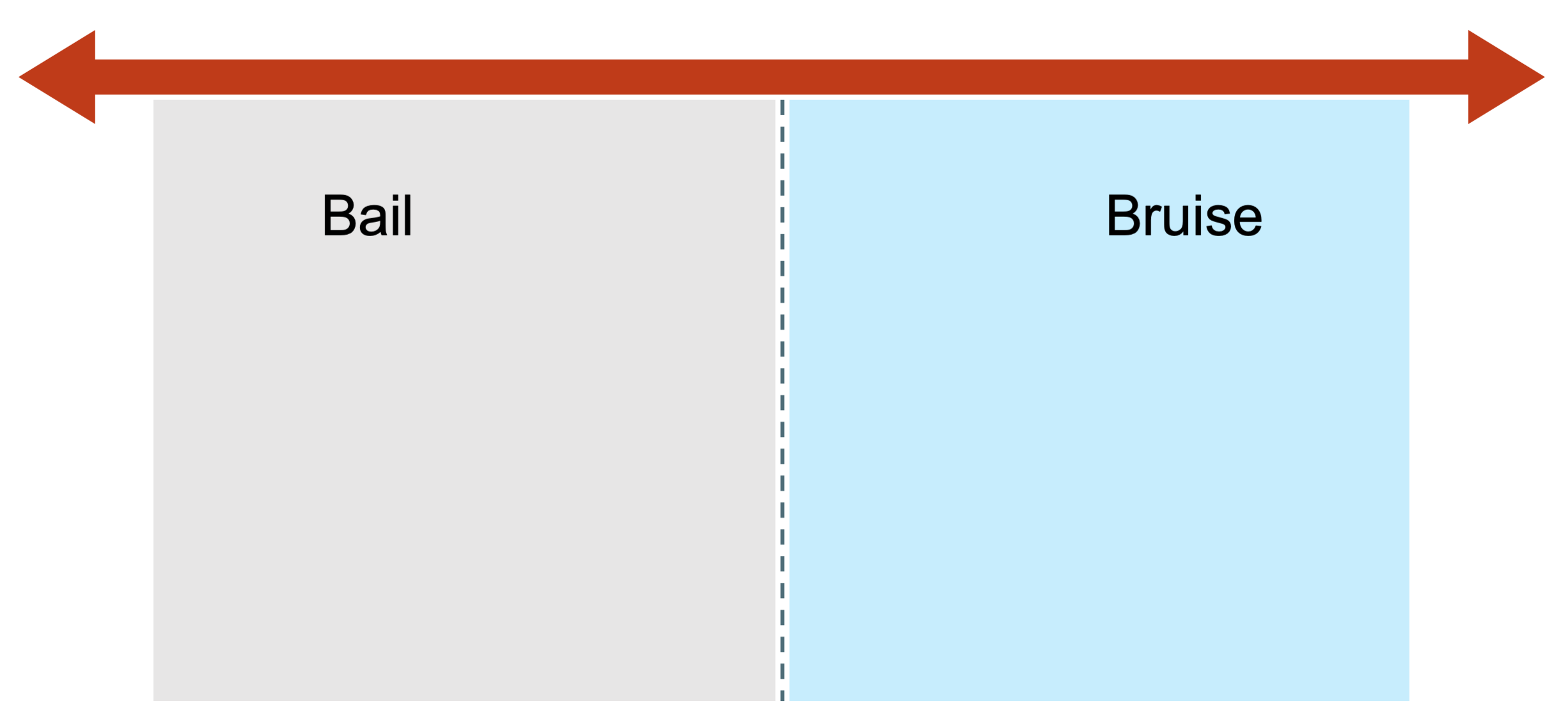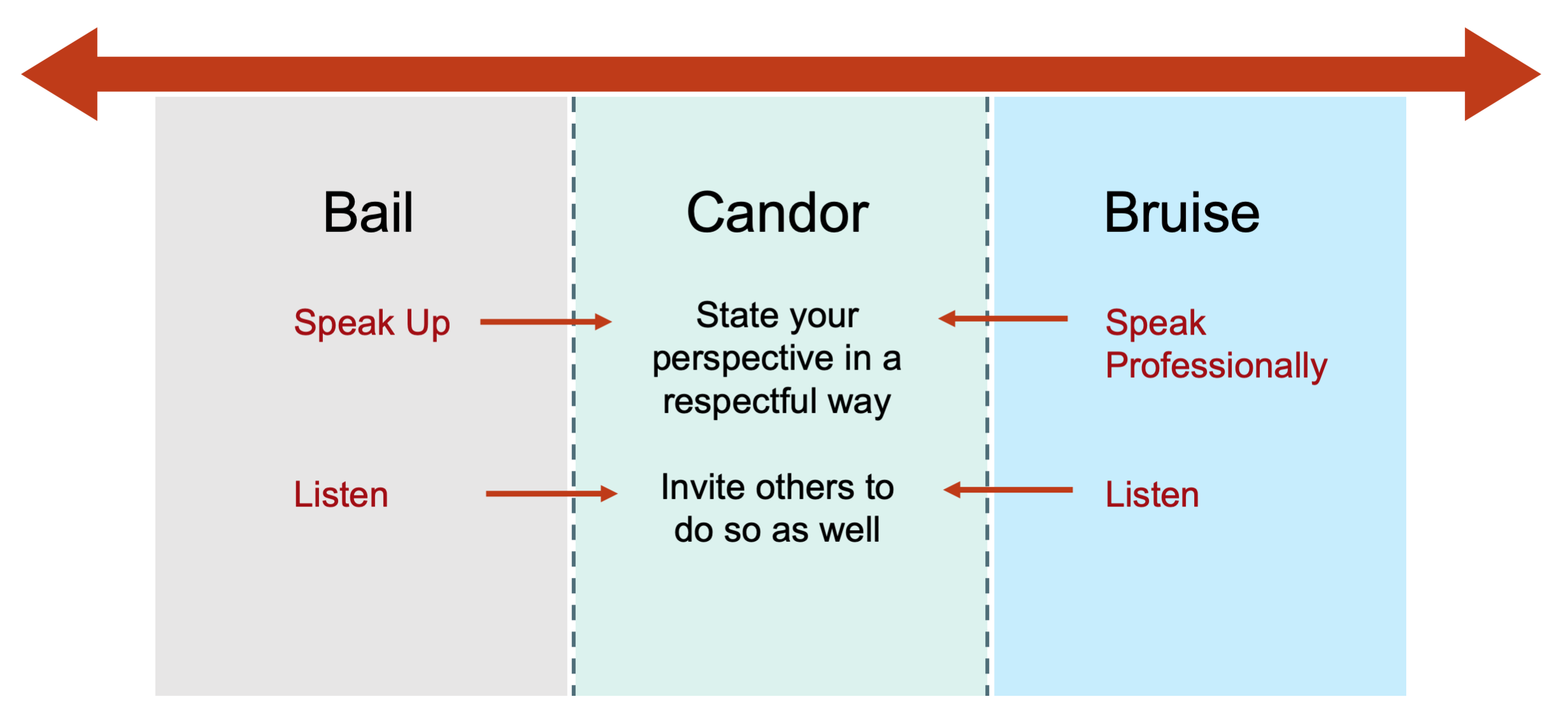If there’s been a theme to the conversations I’ve had with clients this year, it’s the growing cost they’re experiencing related to this bail-bruise dynamic. For one client, it undermines their inclusion and engagement efforts, effecting their ability to retain and compete for talent. With another, it undermines their innovation efforts. For a third privately-held company, it is complicating an ownership and leadership change. For a fourth, it’s a drag on their performance goals. So what is this bail-bruise dynamic, and what can you do so it doesn’t undermine your success as well.
We see bailing and bruising as being on opposite ends of a candor continuum. They represent a conversational version of the fight-flight response.

People whose “fight” response gets triggered in a conversation are likely to bruise, to dominate a conversation and speak in stronger, more unilateral language that can shut others down:
“That will never work…”
“Of course you’d take Maria’s side against mine…”
(Sarcastically) “Oh, that’s a GREAT idea…”
Bailing on the other hand is the conversational version of “flight.” When people worry that they’ll get challenged, shot, down, or lose face in some way, rather than speak up they acquiesce or remain silent. But (contrary to what bruisers may believe) silence doesn’t equal consent. When people withhold their judgement and ideas they withhold their commitment too. That’s why this dynamic is so damaging and costly to organizations. The lack of psychological safety becomes a black hole for engagement, inclusion, and innovation efforts.
The challenge for organizations struggling with the bail-bruise dynamic is to move into the candor zone depicted in the graphic above. People often associate candor with “brutal honesty,” but real candor has a more welcoming tone. The American Heritage Dictionary defines candor as “frankness or sincerity of expression; openness,” and “freedom from prejudice; impartiality.” It’s derived from the Latin word candēre meaning to shine which is the same root for “kindling.” I like to think of candor as the kindling that sparks teams to engage with each other and the challenges they face in fresh, authentic ways.
To move from bail-bruise ends of the continuum into the candor zone three things need to happen.

Bailers need to speak up.
Bruisers need to speak more professionally.
Everyone needs to listen.
People are often surprised to see listening as a key ingredient of candor; we mostly think of candor as being about what is said. But listening is actually the key to the process. Sincere and open listening invites bailers to speak up, knowing that their ideas and reactions will get a fair hearing. Listening also invites bruisers to stop pushing their agendas so hard since listening acknowledges and validates their perspectives as well.
If this style of interacting—professional speaking and skillful listening—sounds easy and conflict-free, it isn’t, at least not when teams are discussing things that really matter. Just because people are listening doesn’t mean they agree with what they’re hearing. High-candor conversations may actually seem messier and more chaotic – after all, the bailers are now speaking up, adding more competing ideas and dissenting opinions to the mix. And even though these ideas and opinions are stated and discussed professionally, individuals still have strong feelings for some ideas and against others.
Here’s the difference between candor-rich conversations and the norm. Everyone is engaged. Everyone’s perspective is heard. Everyone is open to others’ points of view. Even if their ideas didn’t win, participants feel their contributions helped shape the conversation and their commitment to the outcome is higher because of it.
Candor isn’t a panacea and it isn’t the only variable in creating more engaged, inclusive, and innovative teams and cultures. But I don’t know of any team or organization that’s been successful in these areas without strengthening their candor. Even Jack Welch, the hard-nosed CEO of General Electric in the 1980s and 1990s, is a believer in this way of relating. He devotes an entire chapter to candor in his 2005 best-seller Winning. When teams practice candor, he writes “more ideas get surfaced, discussed, pulled apart, and improved. Instead of everyone shutting down, everyone opens up and learns.” That’s what inclusion, engagement, and innovation are all about.
He didn’t stop there: “Any organization—or unit or team—that brings more people and their minds into the conversation,” says Welch, “has an immediate advantage.”
If you’re looking for an advantage yet are struggling with the bail-bruise dynamic in your organization, give me a call or check out Ridge’s Candor Quick-Start Guide. It includes tips for bailers to speak up, for bruisers to speak more professionally, and for everyone to listen more openly.
Good luck, and thanks for listening!

Leave A Comment